Pump Handbook by Igor J. Karassik, Joseph P. Messina, Paul Cooper, Charles C. Heald - 3rd edition
Подождите немного. Документ загружается.

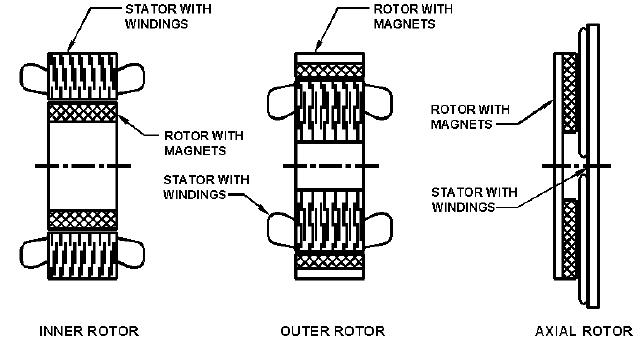
6.12 CHAPTER SIX
FIGURE 12 Inner, outer, and axial rotor PM brushless motor choices for pump drives
to one-half of the other two magnet choices. By careful design, this magnet material can
be used for 50 hp (37 kW) and up in PM brushless machines to keep costs competitive with
other machine types. For brushless motors less than 50 hp (37 kW), the two high energy
or rare earth magnet grades are frequently useful. The more expensive of the two, Samar-
ium Cobalt, is used for high temperature and other hostile environment pump motor
applications. The newer rare earth magnets, known as Neodymium Iron Boron, are much
lower in cost, with the highest useful magnetic flux at moderate operating temperatures.
Either the magnets can be assembled onto the surface of the rotor or they can be imbed-
ded within the laminated rotor structure. In either design, the rotor can be made to be
quite robust and yield a very long useful operating life. In fact, the only failure modes for
PM brushless motors have to do with bearings or winding insulation. Figure 13 shows
examples of large PM brushless motors.
The speed can be controlled to greater than 100 to 1 if required with constant power
over the highest speed range of any other motor type. The efficiency remains very high
over the entire speed range. There are many design possibilities including axial gap and
outside rotor configurations. For example, because of the high magnetic strength of the
permanent magnets, the rotor of a PM brushless motor can also serve as the impeller of a
pump that is integrated with the motor in a hermetically sealed package with no shaft
seals. Utilizing the axial-gap rotor configuration of Figure 12, the concept is illustrated in
Figure 14. Commercially significant impeller torque levels can be generated by the PM
brushless motor in this configuration
1
. This eliminates the need for a separate magnetic
coupling or larger-size canned induction motor (see the discussion at the end of this sec-
tion and in Section 2.2.7).
The PM brushless motor can be driven with either square wave currents over a 120
degrees electrical commutation angle or with sinusoidal currents over 180 degrees elec-
trical commutation angle. The latter scheme generally yields lower torque fluctuations,
which is sometimes important for pump applications. Either drive requires shaft angle
feedback data to tell the phases when to be powered. This feedback data is also a require-
ment for vector driven ac induction motors. The sensor used for this feedback can be as
simple as Hall switches mounted in the motor that send out a pulse to the controller each
time a rotor magnetic pole changes polarity as the motor rotates. An optical encoder or a
resolver can also be used for this purpose. Several sensorless or remote sensors have been
developed that capture the rotor angle location from the stator phase windings so a shaft-
mounted sensor is not required.
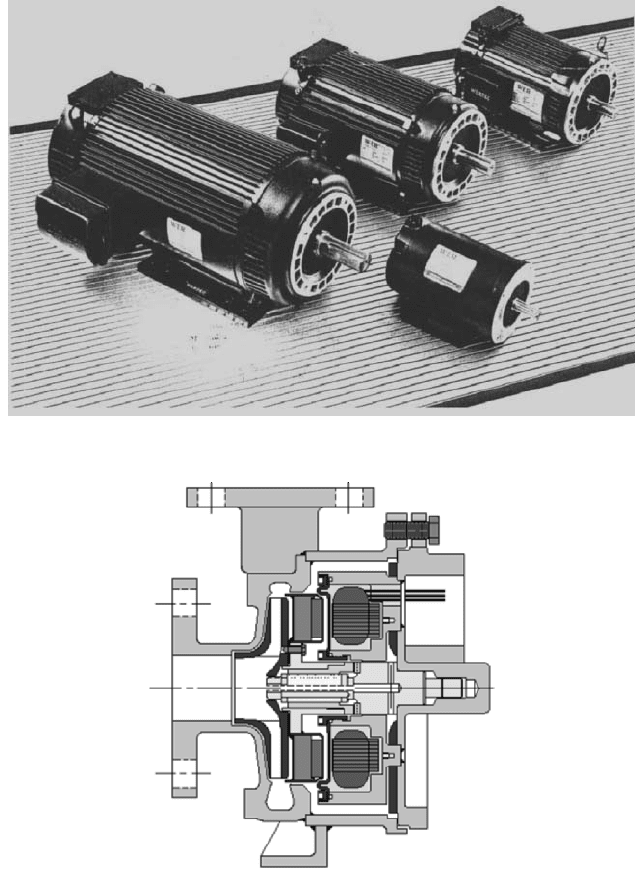
6.1.1 ELECTRIC MOTORS AND MOTOR CONTROLS 6.13
FIGURE 13 Large horsepower (kW) high-performance permanent magnet inside rotor brushless motors
(courtesy of Pacific Scientific)
FIGURE 14 Permanent magnet brushless motor integrated into a seamless pump. Permanent magnets are
mounted on the impeller, which serves as the rotor of the motor. (Courtesy of Flowserve Corporation)
1
Switched Reluctance Brushless Motor The SR brushless dc motor is one of the old-
est motors known, but it has not been used much until recently. Its main feature is that
it is a true brushless motor with most of the virtues of its PM cousin, but it does not
require permanent magnets. This feature is a great benefit for the PM brushless motor
when it is used in a hermetic pump application. However, the PM brushless motor is lim-
ited in the availability of practical sizes because of the cost of permanent magnets. As the
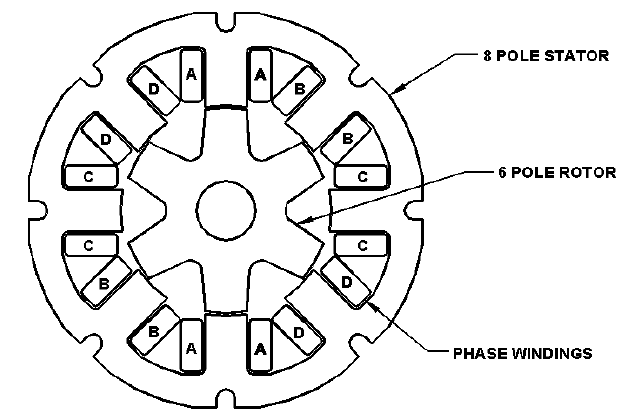
6.14 CHAPTER SIX
FIGURE 15 Switched reluctance brushless dc motor, (6) rotor poles, (2) stator poles per phase
PM motor gets larger in power and frame size, the cost of the magnets becomes prohibi-
tive. The ac induction motor is still a very good choice for most high-power applications,
even when adjustable speed is needed. However, as centrifugal high-speed pumps gain
popularity, the ac induction motor has difficulty surviving the forces on the rotor. Propo-
nents of switched reluctance motors point out its inherent robustness. The rotor of the SR
motor is so simple and rugged it can survive very at high speeds as well as in a variety
of other unusual environmental conditions. Figure 15 shows the typical cross section of a
switched reluctance motor, illustrating how simple this motor is with phase coils placed
around the stator poles. The rotor consists of a set of magnetic steel gear-shaped lamina-
tions taken from the bore of the stator laminations. They are stacked and retained on the
motor shaft. No magnets or windings of any kind are required to produce torque. The SR
motor is said to be a doubly salient pole machine. The torque is produced by the magnetic
attraction of the closest rotor poles to those stator poles which are magnetized by the
phase coils. There is an abundance of technical information regarding the performance
details of this technology. The important point is that the SR motor is an excellent choice
for high-speed high-powered centrifugal pumps.
There is a considerable difference in the inverter topology for the SR motor as com-
pared to either the PM brushless or the ac induction motor. The SR machine must be dri-
ven as a unipolar machine rather than a bipolar motor like the other two. This means the
standard ac inverter cannot be used for the SR motor. The phases are each connected to
the dc power in parallel rather in the standard bridge fashion with all of the phases con-
nected together at a center tap. Figure 16 shows the normal power circuit for the (4) phase
SR motor shown in Figure 15. The same circuit is applicable for both two phase or three
phase. It is essentially an independent half bridge circuit for each phase. Certain two
phase designs are very cost effective for high speed pump drives that are required to rotate
in only one direction without the need for reversing.
MOTOR ENCLOSURES ________________________________________________
Electric motors are manufactured with a variety of mechanical enclosure features to pro-
vide protection to the working parts for specific environmental conditions.Although these
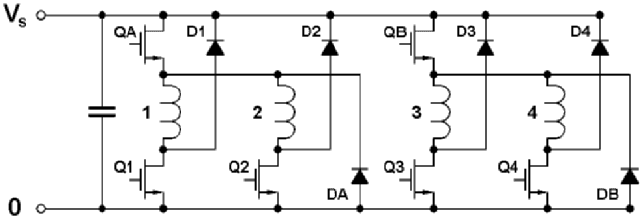
6.1.1 ELECTRIC MOTORS AND MOTOR CONTROLS 6.15
FIGURE 16 Power control circuit for (4) phase SR motor, (6) transistors, (6) diodes, (3) current sensors, (1)
capacitor, and (6) motor lead connections
special enclosures are classified, they are not, for reasons of economy, available for all size
motors. The electric motor industry has incorporated a number of specific enclosure clas-
sifications on standard designs of small- and medium-size motors.
The following list describes the motor enclosure specifications available for polyphase
ac induction motors used with pumps.This availability depends on demand. Furthermore,
the PM brushless and SR brushless motors might not be available in some of the enclo-
sures listed. In general, totally enclosed motors are required for most integral horsepower
(kilowatt) pump applications regardless of the motor type. In some instances, such as high-
speed centrifugal pumps with integral motors, the motor is furnished to the pump manu-
facturer as a rotor and stator parts kit. The motor is then included in the pump enclosure.
OPEN This enclosure permits passage of external cooling air over and around the wind-
ings and rotor of a motor and normally includes no special restrictions to ventilation other
than those that are inherent in the mechanical parts of the motor. Most designs include
openings at each end of the motor frame either in the bearing end frame or openings
around each end of the frame.
OPEN DRIPPROOF This is an open machine with ventilating openings designed to permit
satisfactory operation when liquids or solids fall on the machine at any angle up to 15°
from the vertical. Openings are normally in the bottom portions of the frame assembly.
This construction includes mechanical baffling to prevent materials from entering the
machine within these limits.
SPLASHPROOF This is an open machine with ventilating openings designed to permit sat-
isfactory operation when liquids or solids fall directly on the machine or come toward the
machine in a straight line at any angle up to 100° from the vertical.
GUARDED ENCLOSURE This provision limits the size of the ventilating opening to prevent
accidental contact with the operating parts of the motor other than the shaft.
SEMIGUARDED This is an open construction where some of the ventilating openings are
guarded and the remaining openings are left open.
OPEN, EXTERNALLY VENTILATED This motor is ventilated by a separate motor-driven blower
mounted on the motor enclosure (piggyback construction).

6.16 CHAPTER SIX
OPEN, PIPE-VENTILATED
This motor is equipped to accommodate an air-inlet duct or pipe
for accepting cooling air from a location remote from the motor. Air is circulated in the
motor either by its own internal blower parts or by an external blower, in which case the
motor is said to be forced-ventilated.
WEATHER-PROTECTED TYPE I
This is an open-construction motor with ventilating openings
to minimize the entrance of rain, snow, and airborne particles to the motor’s electrical
parts, and with the openings arranged to prevent the passage of a -in (19-mm) round rod.
WEATHER-PROTECTED TYPE II
This construction has the same features as the type I
machine, but in addition the intake and discharge ventilating passages are designed so
high-velocity air and airborne particles blown into the machine by storms can be dis-
charged without entering the internal ventilating passages of the motor leading to the
electrical parts. The ventilating passages leading to the electrical parts of the motor are
provided with baffles or other features to allow at least three abrupt changes of at least
90° for the ventilating air. The intake air path and openings are proportioned to maintain
a maximum of 600 ft/mm (3 m/s) velocity of the entering air.
TOTALLY ENCLOSED This motor is designed without air openings, so there is no free
exchange of air between the inside and outside of the motor frame; the construction is not
liquid- or airtight. Normally the rotor has die-cast air circulating fins at each end to cir-
culate the trapped inside air and improve convection cooling to the frame.
TOTALLY ENCLOSED, FAN-COOLED This totally enclosed motor is equipped with an external
fan operating on the motor shaft to circulate external air over the outside of the motor.
Most motors have cast fins the length of the frame to increase surface area and take
advantage of the fan cooling.
EXPLOSIONPROOF
This totally enclosed motor is designed to withstand an internal explo-
sion of gas or vapor and constructed to prevent ignition by the internal explosion of gases
or vapors outside the motor.
TOTALLY ENCLOSED, PIPE-VENTILATED
This motor enclosure is similar to the open, pipe-
ventilated motor except that it is equipped to accept outlet ducts or pipes in addition to
inlet ducts or pipes.
TOTALLY ENCLOSED, WATER-COOLED
This is a totally enclosed motor cooled by water pas-
sages or conductors internal to the motor frame.
TOTALLY ENCLOSED, WATER-TO-AIR HEAT EXCHANGE
This is a totally enclosed motor equipped
with a water-to-air heat exchanger in a closed, recirculating air loop through the motor.
Air is circulated through the heat exchanger and motor by integral fans or fans separate
from the rotor shaft and powered by a separate motor.
TOTALLY ENCLOSED, AIR-TO-AIR HEAT EXCHANGE This motor is similar to the water-to-air heat
exchanger motor, except external air is used to remove the heat from the heat exchanger
instead of water.
SUBMERSIBLE This totally enclosed motor is equipped with sealing features to permit oper-
ation while submerged in a specified medium at a specified depth.
Environmental Factors The environmental conditions of the pump application dictate
the type of motor enclosures to be used. A brief set of rules for selecting motor enclosures
follows.
DRIPPROOF For installation in nonhazardous, reasonably clean surroundings free of any
abrasive or conducting dust and chemical fumes. Moderate amounts of moisture or dust
and falling particles or liquids can be tolerated.
3
4
6.1.1 ELECTRIC MOTORS AND MOTOR CONTROLS 6.17
MILL AND CHEMICAL MOTOR (TO NEMA FRAME 449T) For installation in nonhazardous, high-
humidity, or chemical applications free of clogging materials, metal dust, or chips, or where
hosing down or severe splashing is encountered.
TOTALLY ENCLOSED, NONVENTILATED OR FAN-COOLED For installation in nonhazardous
atmospheres containing abrasive or conducting dusts, high concentrations of chemical or
oil vapors, where hosing down or severe splashing is encountered.
TOTALLY ENCLOSED, EXPLOSIONPROOF
For installation in hazardous atmospheres containing:
Class I, Group D Acetone, acrylonitrile, alcohol, ammonia, benzine, benzol, butane,
dichloride, ethylene, gasoline, hexane, lacquer-solvent vapors,
naphtha, natural gas, propane, propylene, styrene, vinyl acetate,
vinyl chloride, or xylenes
Class II Group G Flour, starch, or grain dust
Class II, Group E Metal dust including magnesium and aluminum or their commer-
cial alloys.
Class II, Group F Carbon black, coal, or coke dust
NOTE: Under Class 1 only, there are two divisions that allow some latitude on motor selec-
tion. Generally, Class 1, Division 1 locations are those in which the atmosphere is or may
be hazardous under normal operating conditions, including locations which can become
hazardous during normal maintenance. An explosionproof motor is mandatory for Divi-
sion 1 locations. Class 1, Division 2 refers to locations where the atmosphere may become
hazardous only under abnormal or unusual conditions (breaking of a pipe, for example).
In general, a motor in a standard enclosure can be installed in Division 2 locations if the
motor has no normally sparking parts. Thus, open or standard totally enclosed squirrel-
cage motors are acceptable, but motors with open slip rings or commutators (wound rotor,
synchronous or dc) are not allowed unless the commutators or slip rings are in an explo-
sionproof enclosure.
BEARINGS AND LUBRICATION_________________________________________
Very large horsepower (kilowatt) motors are generally supplied with oil-lubricated sleeve
bearings with oil supplied from a reservoir. In some cases, pressurized oil lubrication sys-
tems are installed by the pump manufacturer along with hydrodynamic thrust bearings.
All NEMA frame induction motors are available with ball bearings. These standard ball
bearings are normally permanently grease lubricated. The bearings used in a motor must
be sealed to keep the lubricant inside the bearings and keep contaminates from getting
into the bearings. Double-sealed bearings are common for many pump applications.
Ball bearings are subject to early failure when used in electric motors driven by PWM
inverters. This very common problem must be addressed. It is caused by the high carrier
frequency used in the inverter to generate the sinusoidal currents for each phase. This
results in generation of high common-mode voltages inside the phase windings of the sta-
tor. Because there is an excellent electrostatic coupling between the stator/frame and the
rotor from the windings, a voltage is induced in the shaft. The ball bearings represent the
least-resistant path for a short circuit to the stator. However, the balls seldom actually con-
tact the races because of the film of grease or oil in between. When the voltage builds up
in the shaft until it is greater than the insulating capability of the film of lubricant, the
voltages arc across the lubrication gap and a flashover current goes through the bearing.
In a relatively short amount of time, the bearing races will become grooved, causing the
bearings to become noisy. Metal particulate will then egress from the bearing surfaces as
the process continues, causing catastrophic bearing failures after a few months.
Therefore, all electric motors that are driven by PWM drives must have a shaft
grounding system to provide a low resistance path between the shaft and the motor
6.18 CHAPTER SIX
frame. There are other solutions to this potential problem, which can be discussed with
the motor supplier.
Sleeve Bearings Motors that use oil-impregnated porous sleeve bearings are lubricated
with an oil-soaked wick. These bearings are available in motors up to approximately 1 hp
(0.75 kW). Sleeve-bearing motors larger than 1 hp (0.75 kW) are ring-lubricated. Lubri-
cating oil is drawn up from the bearing sump to the bearing by a ring that rolls over the
top of the motor shaft as the shaft rotates. Larger motors, having bearing heat losses that
cannot be dissipated directly, may require the use of a pressurized lubrication system
wherein oil is pumped into the bearings and allowed to recirculate through a heat
exchanger. The oil delivered to each bearing is metered to provide only the required
amount. A lubrication system composed of heat exchanger, sump, and pump is normally
common to a number of bearings, rather than having a single lubricating pump for each
bearing. Other types of bearings must be used in place of, or in addition to, sleeve bear-
ings when thrust loads are present. Smaller sleeve bearings are in the form of a cylin-
drical shell and are usually made of bronze or steel-backed babbitt metal. Larger sleeve
bearings are usually split on a horizontal centerline, allowing easy assembly and disas-
sembly for inspection and replacement. The bearing housing is also split on the horizon-
tal centerline and held together with bolts between the top and bottom halves.
Rolling Element Bearings All new electric motors manufactured to NEMA standards
use grease-lubricated ball bearings with high radial and thrust load capacities. They are
axially pre-loaded to eliminate any radial or axial play for quiet operation and long life.
Most motor end frames include an outer race locking plate on the shaft end bearing to
prevent race rotation due to output shaft loads. These bearing mounting features are
required for high performance, long life, and high efficiency operation. Most motor man-
ufacturers provide their larger frame sizes with grease fittings for relubrication during
the lifetime of the motor. The smaller frames use bearings that are grease-packed and
sealed for life at the factory and cannot be relubricated.
NEMA motors subject to very high loads and operating temperature in the larger
frames may require oil lubrication to the rolling element bearings. This can be by either
oil circulation within the bearing frame or from a pressurized lubrication system similar
to that used with sleeve bearings. In addition, for motors required to carry very high
thrust loads, quite often in only one direction, taper or spherical roller thrust bearings may
be used.
Hydrodynamic Thrust Bearings Certain types of pump applications, such as very
large vertical pumps, exhibit very high thrust loads that cannot be accommodated by
rolling element bearings. Hydrodynamic bearings, usually with tilting, self-leveling
thrust pads, are used for very high thrust loads. These bearings are sometimes referred
to as “Kingsbury-type” in recognition of the original manufacturer of this bearing type.
This type of bearing is oil-lubricated from a self-contained oil sump or an external pres-
surized pumping system, depending on size and rating.
MOTOR INSULATION__________________________________________________
Insulation systems must be used in a motor to electrically insulate the windings from the
mechanical parts of the motor as well as to insulate the phase winding conductors from
one another. Extra insulation is also required between any adjacent phase windings for
230 or higher voltage motors. In general, the higher the operating voltage, the better the
insulation system must be.
All NEMA-designed electric motors are manufactured with cord laced end turns to
assure that they are positioned so they cannot touch any mechanical parts. In addition, the
phase windings are nearly always impregnated with a varnish by either dipping or trick-
ling into the heated end turns. The purpose of this is to secure the conductors to prevent
them from vibrating between one another, which would wear through the wire insulation
6.1.1 ELECTRIC MOTORS AND MOTOR CONTROLS 6.19
and cause turn-to-turn shorts. This stator varnish also provides some additional insula-
tion protection to the system. For example, this coating makes the windings resistant to
ambient conditions such as moisture. Consequently, a motor insulation system is very
complex, utilizing several different materials, parts, and processes to effectively insulate
the windings.The parts considered in an insulation system include slot cells, phase barri-
ers, conductor insulation, slot wedges, end turn supports, tie material, and winding
impregnation material.
Since the introduction of PWM inverters for use with all types of variable speed drives,
such as ac induction, PM brushless and switched reluctance brushless, a new insulation
system failure mode has emerged. This is a most significant problem in installations
where the inverter is located 50 ft (15 m) or more away from the motor. The long motor
lead cables used in these applications cause very high voltage spikes not present at the
inverter end of the lead cables. These voltage spikes across the first turns of each phase
winding result in the degradation of the wire insulation due to the corona insulation fail-
ure. Special magnet wire insulation and motor manufacturing methods are available to
overcome this problem. Therefore, if an inverter is to be used to drive a pump motor with
long connection cables, an “inverter duty” motor should be specified.
There are four basic classes of insulating materials currently recognized by the motor
industry. Each differs according to its physical properties and can withstand a certain
maximum operating temperature (frequently termed total temperature or hot-spot tem-
perature) and provide a practical and useful insulation life. The insulation classes and
their maximum operating temperatures are
Class A 90°C
Class B 130°C
Class F 155°C
Class H 180°C
Those factors that contribute to the maximum operating temperature of a motor insu-
lation system are the ambient temperature, the temperature rise in the motor winding
caused by motor losses, and any overload allowance designed into the motor (service factor).
The current standard for motors within the range of NEMA ratings (frames 140T to
449T) requires nameplate marking for the maximum allowance ambient temperature, the
power rating, the associated line current needed to develop this power, the class of insula-
tion used, and the service factor provided. Motors larger and smaller than NEMA frame
sizes have nameplate marking for maximum allowable ambient temperature, tempera-
ture rise in degrees Celsius either by thermometer or resistance measurement, power rat-
ing, line current needed to develop this rating, and any service factor provided.
In addition to ambient temperature, there are several additional environmental con-
ditions that must be considered when applying an electric motor. In applications where
chemical fume or moisture levels are abnormal and can cause decomposition of an insu-
lation system, standard insulation will be inadequate. These applications require a motor
with a premium insulation system that will incorporate highly resistant components and
may include special impregnation techniques. Chemical fumes and moisture can also be
destructive to the mechanical parts of a motor, and special protective treatment should be
provided to these parts. NEMA frame-size motors have a special motor for chemical indus-
try applications that has standard features to resist these environmental factors. For
example, these motors usually contain shafts made from stainless steel.
Applications with excessive vibration can destroy a winding and damage the mechan-
ical parts of a motor. In such cases, it is advisable to provide (1) extra treatment for the
winding to ensure that it is rigid and will not vibrate and chafe the insulating materials
and (2) a mechanical construction that will have the strength to withstand the above.
If abrasive dust is present, the motor insulation should be protected with a resilient
surface coating to withstand the impact of the abrasive particles.
Because all insulation systems employ components that can in some degree support
fungus growth in tropical locations, motors applied in such areas should incorporate
fungus-proofing treatment on the insulation.
6.20 CHAPTER SIX
Obviously, applications exhibiting a combination of any or all of the environmental con-
ditions discussed should have special protection for each condition. Applications in
unusual environmental conditions may require special protection and should be discussed
with the motor manufacturer or distributor.
COUPLING METHODS FOR PUMP APPLICATIONS_________________________
Direct Coupling
Pumps are frequently directly coupled to motors, and where the pump
is not close-coupled, it is usually coupled by means of a flexible coupling.The use of a flex-
ible coupling permits minor misalignment (angular and parallel) between motor and
pump shafts. The use of some older style flexible or solid couplings could cause severe
radial and axial loads on the motor bearings. Since the development of the flexible disk
couplings, the earlier coupling designs have largely disappeared, as have the severe loads
resulting from misalignment. The flexible disk coupling is capable of transmitting very
high torque for its size, with minimum radial and axial forces on the shafts resulting from
misalignment. [See Subsection 6.3.1.]
Close-Coupling Close-coupled pumps have become very popular for certain applica-
tions. In this arrangement, no coupling is provided between the pump and motor shafts
and the pump housing is flange-mounted between close-tolerance fits on both the motor
and the pump flanges. The pump impeller is mounted directly on the motor shaft. Care
must be taken in this arrangement to ensure that the motor shaft runout or axial move-
ment plus machine tolerances do not cause interference between the pump housing and
its rotor. This is usually not a problem if properly fitted ball bearings are used in the motor.
The motor shaft material must be compatible with the fluid being pumped, and if the
pump impeller is held in place by a nut, the threat must respect the rotation of the motor.
High-pressure close-coupled pumps of a nonbalanced design can cause excessive shaft
thrust, which may be incorporated in the motor bearing capacity. It is always good prac-
tice with close-coupled pumps to provide some form of flinger on the motor shaft to pre-
vent liquids that leak past the pump seal from entering the motor bearing.
Flanged Motors Flanged motors allow an easy means of aligning pump housings with
motors.This construction is usually in the form of a vertical mounting in which the motor
is set on top of the pump and the pump supports the motor weight. The pump and motor
shafts are normally coupled, and those comments made under the subject of direct-
coupling methods are applicable. Also, as in the case of coupled pumps, this construction
permits thrust forces that must be considered when selecting a motor if the pump does
not have a thrust bearing.
A further extension of flange motors includes the vertical hollow-shaft motor. With this
design, a variable length of shafting connects the pump and motor. The pump shaft passes
through the center of the motor bore, and the motor torque is imparted to the pump shaft
by a suitable coupling at the top of the motor. The weight of the shaft and the pump
impeller and the force of the hydraulic thrust are assumed by the motor bearings.
The coupling on the motor can be made a self-release coupling (Figure 17) to prevent
the motor from delivering torque to the shaft in the event the motor is started in the wrong
direction and to prevent reversed motor rotation from unscrewing the threaded joints
between lengths of pump shafting.
Another modification to a coupling is a nonreverse ratchet (Figure 18), which prevents
the remaining head of liquid in a pump from rotating the pump in the reverse direction
when the pump is stopped. This prevents possible overspeeding of the pump and motor
when the pump is connected to a large reservoir and most of the total pump head is sta-
tic. This also prevents a pump with a long discharge column pipe from running in reverse
with no liquid in the upper portion of the pipe to lubricate the line shaft bearings. Start-
ing a pump capable of back spinning is also prevented.
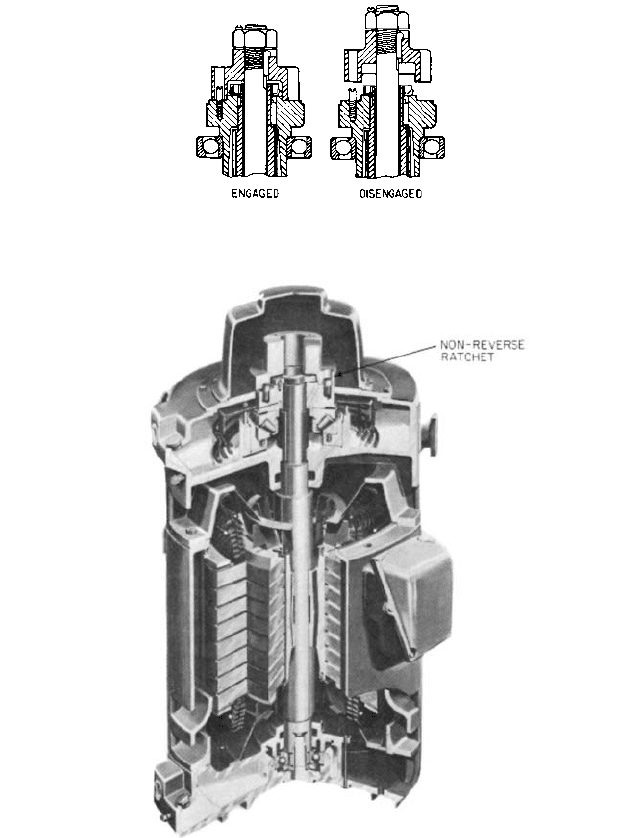
6.1.1 ELECTRIC MOTORS AND MOTOR CONTROLS 6.21
FIGURE 17 Self-release coupling connecting pump head shaft to hollow shaft of vertical motor disengages as a
result of pump shaft couplings unscrewing (U.S. Electrical Motors).
FIGURE 18 Section of vertical hollow shaft motor showing nonreverse ratchet. Spring-loaded pins ride on ratchet
plate in one direction only (General Electric).
PERFORMANCE _____________________________________________________
Ac induction motors are designed to produce their rated power at a certain speed at a spe-
cific line voltage, line frequency, and ambient temperature. These motors will also operate
at a specific efficiency and power factor when all of these conditions are met. The normal
operating conditions of a motor are stipulated on its nameplate with values for power,
